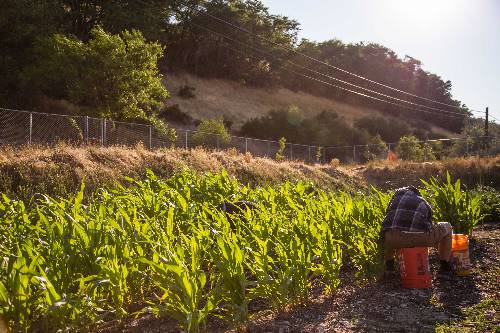Urban Agriculture: Growing Food in City Environments
Urban Agriculture: Growing Food in City Environments
Blog Article
Enhance Agricultural Efficiency With High-Quality Water Soluble Polymers
These polymers provide an array of benefits that can change standard farming techniques, from boosting water retention and efficiency to maximizing dirt structure and nutrient distribution systems. By taking advantage of the power of innovative polymer services, farmers can possibly open brand-new paths in the direction of achieving greater crop yields while reducing ecological influences.

Advantages of Water-Soluble Polymers
Water-soluble polymers use a wide variety of advantages in agricultural applications because of their boosted water retention properties and capacity to improve soil framework. Agriculture. These polymers, when contributed to the soil, can significantly enhance water holding capability, decreasing the frequency of watering required by plants. By forming a gel-like compound when blended with water, water-soluble polymers create a storage tank that slowly releases moisture to plant roots, guaranteeing an extra consistent water system throughout completely dry spells
Additionally, these polymers assist in preventing soil erosion by binding dirt particles with each other, thus improving soil structure and security. Improved soil framework enables better root penetration and aeration, promoting healthier plant development and higher plant returns. Water-soluble polymers likewise aid in nutrient retention by reducing leaching, making sure that essential nutrients stay offered to plants for a longer duration.
Improved Water Retention and Performance
Enhancing farming water retention and effectiveness via the consolidation of advanced polymer innovations has actually become a vital focus in modern farming practices. Water-soluble polymers play a vital duty in improving soil framework, boosting water seepage, and decreasing water dissipation prices. By developing a thin film on the dirt surface area, these polymers assist to stop water overflow and raise the dirt's water-holding ability, ensuring that plants have accessibility to an ample water system.
In addition, the use of high-quality water-soluble polymers can significantly reduce the regularity of watering, as they enhance the dirt's capability to keep moisture for longer periods. This not only saves water but additionally lowers the energy and labor costs connected with irrigation practices. Furthermore, boosted water retention and effectiveness cause much better nutrient uptake by plants, causing enhanced plant returns and general agricultural efficiency.
Boosted Nutrient Shipment Solution
Given the substantial impact of top quality water-soluble polymers on enhancing water retention and performance in agriculture, the emphasis now changes in the direction of enhancing nutrient delivery systems to better improve plant growth and return. Enhanced nutrient shipment systems play a vital role in guaranteeing that plants obtain the necessary nutrients in a type that is conveniently available for uptake, advertising their overall health and efficiency. By integrating water-soluble polymers into nutrient distribution systems, the performance of nutrient uptake by plants can be substantially enhanced.
One trick advantage of making use of high-grade water-soluble polymers in nutrient shipment systems is their ability to control the launch of nutrients, ensuring a steady and regulated supply to plants over a prolonged duration (Agriculture). This controlled release system aids stop nutrient leaching and overflow, thus making best use of nutrient utilization by crops and decreasing environmental effect

Dirt Framework Optimization Techniques
Maximizing dirt structure is critical in modern farming for making the most of crop returns and advertising lasting land administration practices. Dirt framework optimization methods play a vital role get redirected here in ensuring that soil supplies a suitable environment for plant development. One essential strategy is the addition of raw material, such as compost or manure, which assists improve soil framework by enhancing its water-holding ability and nutrient retention.
Additionally, exercising minimum husbandry or no-till farming Full Article can stop dirt compaction and advertise the development of a healthy dirt framework. Cover chopping is an additional reliable technique that includes growing crops particularly to improve the soil and secure, avoiding erosion and improving dirt framework.
Moreover, applying crop rotation techniques can assist damage parasite and condition cycles, while additionally boosting soil structure with the varying root frameworks of various plants. On the whole, using these dirt framework optimization strategies can lead to increased agricultural productivity, reduced ecological impact, and lasting sustainability in farming techniques.
Lasting Solutions for Plant Yields

To address the challenges of making best use of crop yields while advertising lasting land monitoring techniques, exploring sustainable services comes to be vital in contemporary farming. One lasting option for enhancing crop yields is the use of precision agriculture techniques.
Additionally, promoting plant turning and cover cropping can help maintain soil health, reduce erosion, and improve nutrition cycling, ultimately adding to higher yields over time. Integrated parasite management approaches likewise play an essential function in lasting plant production by decreasing the reliance on chemical pesticides and advertising all-natural pest control techniques.
Additionally, buying research and development for developing drought-resistant plant varieties and climate-resilient farming methods can help alleviate the influence of climate modification on farming while guaranteeing consistent returns despite ecological difficulties. By embracing these sustainable solutions, farmers can accomplish greater crop returns while safeguarding the wellness of the land for future generations.
Final Thought
Finally, using high-grade water-soluble polymers in farming provides many advantages such as enhanced water retention, boosted nutrient delivery systems, and enhanced dirt framework. By implementing lasting options for crop returns, farmers can substantially increase farming productivity and effectiveness. Agriculture. Water-soluble polymers give a environmentally pleasant and affordable technique to boost the general performance of farming practices, resulting in much better end results for both farmers and the environment
These polymers use a variety of advantages that can transform conventional farming techniques, from improving water retention and performance to optimizing dirt framework and nutrient shipment systems.Additionally, these polymers assist in preventing soil disintegration by binding soil bits together, thereby improving soil framework and security. By forming a thin film on the dirt surface area, these polymers assist to prevent water drainage and enhance the dirt's water-holding ability, making certain that plants have accessibility to an ample water supply.
Dirt framework optimization methods play a crucial duty in guaranteeing that soil offers a perfect environment for plant development.In verdict, the use of top quality water-soluble polymers in agriculture uses countless benefits such as improved Read Full Report water retention, improved nutrient delivery systems, and optimized dirt structure.
Report this page